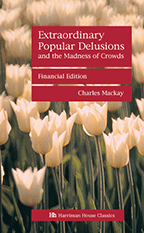 (128 pages, $14.68 softcover, 2013, 978-0-857-19317-9) by Charles Mackay, published by Harriman House.
(128 pages, $14.68 softcover, 2013, 978-0-857-19317-9) by Charles Mackay, published by Harriman House.BOOKS FOR TRADERS
 (128 pages, $14.68 softcover, 2013, 978-0-857-19317-9) by Charles Mackay, published by Harriman House.
(128 pages, $14.68 softcover, 2013, 978-0-857-19317-9) by Charles Mackay, published by Harriman House.
First published in 1841, this classic is often cited as the best book ever written about market psychology. This Harriman House edition includes Charles Mackay’s account of the three infamous financial manias — John Law’s Mississipi Scheme, the South Sea Bubble, and Tulipomania. These historic episodes show that greed and fear have always been the driving forces of financial markets. With the benefit of hindsight, Mackay was able to record a passage of events that was inevitably heading for disaster, resulting in a work that is both a thriller and a historical document.
additional information: www.harriman-house.com
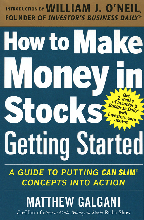 (279 pages, $18 softcover, 2013, ISBN 978-0-071-81011-1) by Matthew Galgani, published by McGraw-Hill Education.
(279 pages, $18 softcover, 2013, ISBN 978-0-071-81011-1) by Matthew Galgani, published by McGraw-Hill Education.
This book is the latest addition to the How To Make Money In Stocks series begun 25 years ago by William J. O’Neil, founder of Investors Business Daily (IBD) and developer of the well-known CAN SLIM method of investing. Matthew Galgani is the co-host of the IBD weekly radio show and editor of the IBDextra! newsletter. Galgani’s book provides an easy-to-follow plan designed for busy people with a limited amount of time to spend on investing. In his book, Galgani presents buying & selling checklists; some simple weekend and daily routines for investors; chart-reading tips; what to consider before you buy a stock; and action steps to get started quickly.
additional information: www.mheducation.com
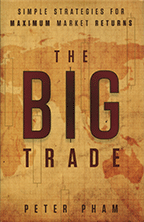 (224 pages, $29.95 hardcover, 2013, ISBN 978-1-118-49895-8) by Peter Pham, published by Wiley.
(224 pages, $29.95 hardcover, 2013, ISBN 978-1-118-49895-8) by Peter Pham, published by Wiley.
The Big Trade guides traders to determine the probability that a stock’s price will rise or fall in a particular time period. The financial markets, and trading systems, can be extraordinarily complex. This book presents a new system that seeks to filter out some of the noise, leaving behind meaningful signals for trades. Pham’s approach codifies past behavior of a stock to help discern high-probability trading patterns. Pham’s system breaks with traditional analytical tools and rejects the idea of predictability. Instead, he covers how markets are structured and how they behave, producing a simple action plan that is as applicable for daytraders as it is for generational investors.
additional information: www.wiley.com
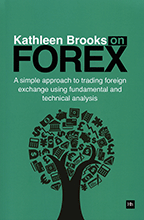 (127 pages, $22.93 softcover / $20 ebook, 2013, ISBN 978-0-857-19205-9) by Kathleen Brooks, published by Harriman House.
(127 pages, $22.93 softcover / $20 ebook, 2013, ISBN 978-0-857-19205-9) by Kathleen Brooks, published by Harriman House.
Many foreign exchange traders use either fundamental analysis or technical analysis, and they’re often considered to be mutually exclusive approaches. Brooks fuses the two types of analysis for improved research and better trading results. At the heart of her trading philosophy is the principle that fundamental factors — politics, economics, and societal changes — cause currency prices to move in the medium to long term, but throughout the trading day, price movements are based on technical factors. Read about how she performs her pre-trade market analysis, forms a plan, puts the plan into action, and applies risk management.
additional information: www.harriman-house.com
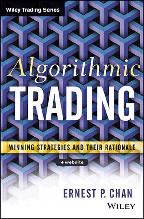 (224 pages, $70 hardcover, 2013, 978-1-118-46014-6) by Ernie Chan, published by Wiley.
(224 pages, $70 hardcover, 2013, 978-1-118-46014-6) by Ernie Chan, published by Wiley.
Following Quantitative Trading, Chan’s latest book is a guide for algorithmic trading strategies for institutional traders or serious retail traders. Chan reviews some of the best financial research done in the last few decades and provides his own insights. Broadly divided into the mean-reverting and momentum camps, the book lays out standard techniques for trading each category of strategies as well as the reasons why a strategy should work. The emphasis throughout is on simple and linear strategies that avoid data overfitting that often plague complex strategies. The goal of the book is to offer a realistic assessment of common algorithmic trading techniques.
additional information: www.wiley.com
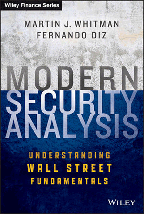 (496 pages, $75 hardcover, 2013, ISBN 978-1-118-39004-7) by Martin J. Whitman and Fernando Diz, published by Wiley.
(496 pages, $75 hardcover, 2013, ISBN 978-1-118-39004-7) by Martin J. Whitman and Fernando Diz, published by Wiley.
additional information: www.wiley.com